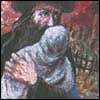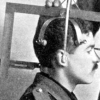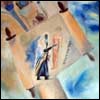Editor's Note: Rabbi Yossi Lew, assistant rabbi of Chabad-Lubavitch of Georgia, accompanied the Atlanta delegation on this year's March of the Living, a tour of Jewish communities and concentration camps in Poland, followed by a week in Israel, for high school students. As he's done in year's past, Lew provided rabbinical guidance on the trip. He wrote a diary about his experiences and those on his bus, as they came to terms with the horrible reality that was the Holocaust. This is the first of several installments.
April 29, Arrival in Berlin
The bus is rumbling along the Autobahn, the German highway of speed, through the pretty countryside of eastern Germany. No wonder why Prussia was considered a beautiful place: It still is. The plush forests on either side of us seem to fly by; the branches of the trees are like the spread wings of large birds. Little villages peep out from between the trees and hills, tucked away in sleepy hideaways.
"Come on, run-on," seems to be the message. Oh, we're running now – away. The signs on the highway point to Dresden in one direction and to Frankfurt in the other. The Bavarian country-side continues to unfold its glorious green carpet.
Most of the students on the bus have fallen asleep long ago; the adults are, by now, also long gone. We are driving east, towards Poland and its capital, Warsaw. A bed awaits us there. Finally, some rest for our weary bones, in Poland, of all places.
It has been a long night and a long day. We did not get much sleep on our way across the ocean. The kids were too excited to sleep, and they made sure that the adults would feel the same way. Only now, after traveling through Berlin and passing some of East Berlin's ugly reminders of Communist times, can some of us take some time to think and reflect on what we just left.
The truth? The quicker we get to Poland, the better.
As we walked out of Berlin's airport, a cold gust of wind hit us. That should be expected, of course. It is the end of April, when spring is trying to paint away the winter, and the winter refuses to depart without a few gusty shots.
The cold wind, though, was also a perfect companion to what so many of us felt inside the airport. Every time the announcer's voice boomed from the airport's speakers, it sounded like so many audio and video clips from the 1930's and 1940's.
And that is a cold feeling. Uneasy, I should say. Something just does not feel right and comfortable here.
True, Germany of today in not the same Germany of the 1940's. And it is completely unfair to project the Holocaust and its ramifications onto present day Germany. Germany has tried so hard to make amends. It is one of only two countries where Holocaust denial is a crime (the other is Austria).
But right now, being that the Holocaust is so recent and that survivors continue to walk and function in our midst, Germany still sounds too eerily familiar to a very dark and terrible past.
So I decided to ask my friend, Max Glauben, a survivor of six concentration camps, about his feelings while in Berlin. He did not hesitate. He said that today was the first time in his life he had ever been to Germany, and as far as he is concerned, today was a victorious day.
"They wanted us out of here, didn't they?" he asked. "Well, here I am, in your face."
April 30, From Tykocin to Treblinka

The scenery is downright gorgeous: lush green fields, sporadically interspersed by Eastern Europe's famous forests and thick woods. There are plowed fields, planted fields, even growing fields. Villages appear as if they are awakening to a bright, sunny morning, its families waiting to go on a picnic to the country for the day. If those little homes didn't have satellite dishes hanging from their walls, you could easily mistake this for 1908, 1808, or 1708.
Nature seems to be performing its dance of sweet synthesis between blue, white, brown, and various shades of green. Birds of all sizes are enhancing this dance.
Dancing is something everyone can do. When do we dance? Usually when we feel up to it, or at joyous occasions like weddings, or Bar or Bat-Mitzvahs.
It would be safe to say that no one has danced at a funeral, or watched others dance at one. Could there be such a thing as the "Dance of Death"?
We came pretty close, however, today. We danced at the synagogue of Tykocin, a shul that's almost 500 years old. The shtetl, though, was emptied of its Jews back in 1941. There are no Jews left, but there is plenty of Judaism.
We danced in that shul, bereft of worshipers and left for dead. Hopefully, that prolific dance, which we carried outside, introduced some much needed life into a place of so much death.
Later, when we were in the forest where the Nazis slaughtered the remaining 2,000 Jewish men, women and children, there was no dance. Only death, incomprehensible, intolerable. For each of the three times that I have been on the March of the Living, it has always amazed me that, despite us not telling the students or the adults very much about the forest and its holy martyrs, an eerie and pregnant silence pervades the atmosphere of the group. There is no dancing here.
In Treblinka, where 800,000 human beings, mostly Jewish, were slaughtered, the Atlanta students presented to other March participants a phenomenally moving ceremony, focused on the duality of the Jewish people. Through thousands of years of persecution, murder and destruction, the faith of the Jewish people, their emunah, has continued to keep them dancing the dance of life. It was there that we sang songs to bring some much-needed spirit to this place of death.
As we were traveling towards Tykocin, we heard from the survivor on our bus. This beautiful person also spoke to us as we traveled from Treblinka back to Warsaw. Her name is Sheila Wiener, and she is originally from Rovno, Ukraine. Sheila's daughter and grand-daughter, both from Atlanta, are also on our bus.
Sheila told us of her childhood and of the horrors she faced as she watched friends and neighbors murdered in front of her young eyes.
Personal, eyewitness accounts from courageous survivors who were there make the Holocaust real. Sheila's tale of escape, hiding and years of fear is breathtaking and awful. The Holocaust is not just about the 6 million holy martyrs, but also about those who survived and lived, and rebuilt Judaism, while being forced to contend with the horrors of their youth.









Start a Discussion